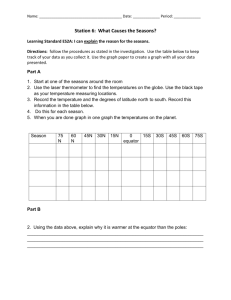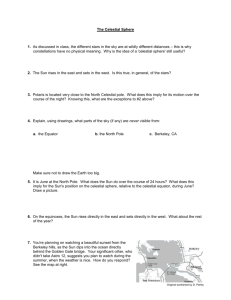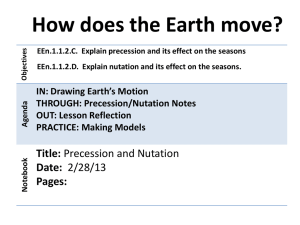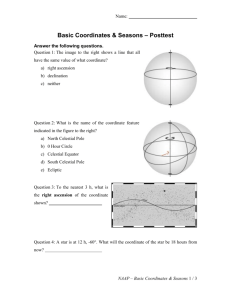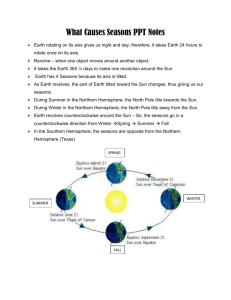The Sky Part 3: Precession and Sun Cycle
advertisement
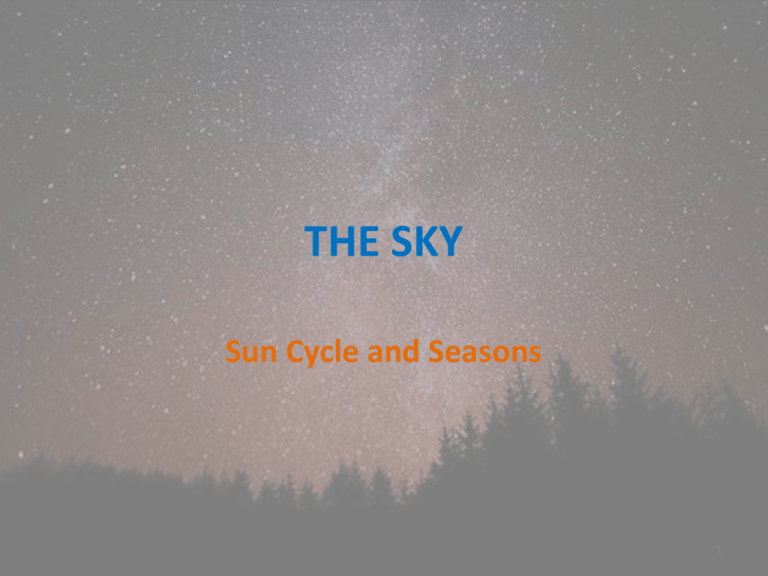
THE SKY Sun Cycle and Seasons 1 Objectives • To be able to describe how the sky moves with reference to the Earth’s rotation. • To be able to predict the seasons and describe what causes them. • To be able to synthesize information on astronomical cycles to predict Earth’s climate. 2 Precession • Earth spins like a giant top, and like a giant top, its weight tips it. • Earth is tipped 23.5 degrees from vertical. • Earth’s large mass and rapid rotation keep its axis of rotation pointed toward a spot near the star Polaris. 3 Precession • Due to its rotation, Earth has a slight bulge around its middle – gravity from the sun and moon pull on the bulge twisting Earth on its axis. • The result is that the twisting of the axis of rotation combines with the rotation of the Earth causing precession. • Earth’s axis precesses, taking about 26,000 years for one cycle. 4 Precession and the North Star In 13,000 years, Polaris will have given up its status as the north star. That mantle will go to Vega, a much brighter star than Polaris. 5 Precession • Video showing how Precession works. • Can be found at http://www.youtube.com/watch?v=0qHjtp4cd CA 6 The Sky’s Motion • There are a couple of things you should note: – The sky appears to rotate westward around the Earth each day. • This is a result of the Earth’s Eastward rotation. The Sky’s Motion • What you see in the sky depends on your latitude. – Starting at the north pole, the celestial north pole is directly over your head. – As you move south, the celestial pole moves toward the horizon (it moves with you), and you can see farther into the southern sky. – The angular distance from the horizon to the north celestial pole always equals your latitude. The Sky’s Motion – By the time you reach the equator, the north celestial pole sinks below your northern horizon (in other words, it disappears and you are in the southern hemisphere (with the south celestial pole, which is expressed in negative degrees). – As you cross the equator and head south, you see the southern sky with its constellations. Cycles of the Sun • Earth’s rotation on its axis defines the day but its revolution around the sun defines its year. 10 Annual Motion of the Sun • If the Sun were not so strong, you could see it rise in the morning in front of the stars and move across the sky. • Between sunrise and sunset, it moves a distance roughly equal to its own diameter. • As Earth moves around its nearly circular orbit, the sun rises in front of different stars. • So, in March, the sun is in front of Aquarius (people say it is in Aquarius). 11 Annual Motion of the Sun The apparent path of the sun against the background stars is called the ecliptic. 12 Annual Motion of the Sun • • • • Earth circles the sun in 365.25 days. This appears to circle the sky in that period. It moves 1 degree eastward in 24 hours. This “movement” is what gives us seasons. 13 The Seasons • If Earth rotated upright in its orbit, it would not experience seasons; however it is tipped 23.4 degrees on its axis. • Earth goes through a cycle of seasons (except at the equator) because of changes in the amount of solar energy reaching Earth. 14 Tilt of the Earth Note where the shadows fall. You can see where the north pole is perpetually dark when the south pole is perpetually light and vice versa. The directness and thus energy of the sun’s rays change. 15 Tilt of the Earth This picture also shows the spring and autumnal equinoxes (March and September) and the winter and summer solstices (December and June). Seasons in the southern hemisphere are the opposite of ours. 16 Misconception • The seasons don’t occur because Earth moves closer to or farther away from the sun. • In the northern hemisphere we are actually 1.7% closer to the sun during the winter (seasons occur because Earth’s axis is not perpendicular to its orbit). 17 Festivals • All over the world and among the majority of cultures (not so much around the equator), festivals are planned around the solstices and equinoxes. – Ex. Christmas (planned to replace “pagan” celebrations), New Years, “We Xipantu” (sunrise of the new sun) the Mapuche new year celebration in July, etc. – Rosh Hashanah marks the Jewish new year in September. 18



